Results of the year. Analysis of what was on the market of payment systems and a forecast for the future
It so happened that at the beginning of the new year, it was customary to sum up the results of last year and make plans for the coming year. We in Web-payment.ru , a project on payment systems with monitoring of exchangers, decided not to depart from this remarkable tradition and tried to find an answer to the question of what will be in the field of payments in the future, in 2015.
But first, let's stop on the results of the year of the past. So, the expert Karen Webster formulated the main world events of the payment market of the outgoing year.
1. Large-scale cyber attack on the Target distribution network
')
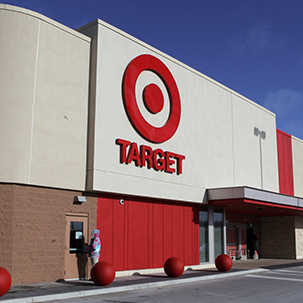 At the end of 2013, a large trading network Target, which is owned by the same-name American company, was attacked by hackers, as a result of which scammers got access to information on 40 million bank cards. After this incident, customer confidence in the network dropped sharply, and with it immediately, sales volumes fell by 46%. How did this event affect payments in 2014, you ask? The most direct.
At the end of 2013, a large trading network Target, which is owned by the same-name American company, was attacked by hackers, as a result of which scammers got access to information on 40 million bank cards. After this incident, customer confidence in the network dropped sharply, and with it immediately, sales volumes fell by 46%. How did this event affect payments in 2014, you ask? The most direct.
Almost immediately after the attack, Target began large-scale work to prevent such attacks in the future. Cyber attack allowed to prioritize the company - henceforth, security is paramount.
Of course, after Target, other retail chains also thought about the security of their customers' personal data. Gradually, during the whole of 2014, a new standard of security for payment transactions was formed, more and more companies put cybersecurity on the first step of their priorities. And now, by the end of the year, we can argue that a cyber attack on the Target distribution network (although this is not the only case of identity theft, there were attacks before and after, but the attack on Target was the most resonant) showed the scale of the possible consequences and prompted all large companies to review their policies and focus on protecting their customers' data. In the future, work on the improvement of protective measures will be continued, including in the sphere of Internet-commerce.
2. Introduction of contactless cards in the USA
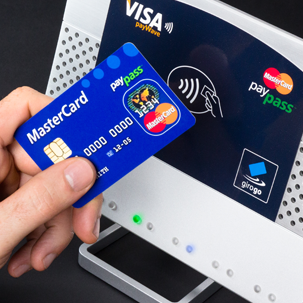 Before the attack on Target, America was skeptical of EMV, the international standard for working with chip cards in general, and contactless payment cards in particular. Most users prefer magnetic stripe cards, considering them completely safe. The peace of mind of cardholders was largely due to the statistics, because before the attack on Target the level of magnetic card fraud was very low. In addition, the introduction of new technology of contactless payments required large cash inflows.
Before the attack on Target, America was skeptical of EMV, the international standard for working with chip cards in general, and contactless payment cards in particular. Most users prefer magnetic stripe cards, considering them completely safe. The peace of mind of cardholders was largely due to the statistics, because before the attack on Target the level of magnetic card fraud was very low. In addition, the introduction of new technology of contactless payments required large cash inflows.
After weighing all the pros and cons, the Americans found unfounded spending on such "trifles". And in vain. After all, a contactless card, thanks to the special encryption of the personal data of its owner, is capable of providing a level of security an order of magnitude higher than its magnetic predecessor.
The cyber attack on Target made its adjustments and forced the US government to reconsider its attitude to the new technology. Currently, both in America and in other countries of the world, active work is being carried out on the introduction of a system of contactless payments.
However, full re-equipment of payment systems will take at least 5 years, and by the end of 2015 only 25% of the total number of payment terminals will accept new-style cards.
3. Introduction of tokenization
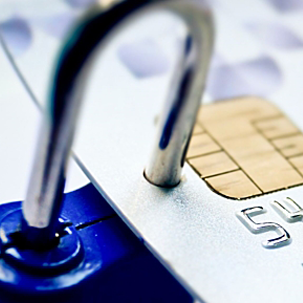 2014, as we have already noted, was a year of safe trading. One of the ways to ensure the security of payments was the introduction of tokenization, the principle of which, however, is no longer new.
2014, as we have already noted, was a year of safe trading. One of the ways to ensure the security of payments was the introduction of tokenization, the principle of which, however, is no longer new.
The service is based on the principles of the EMV-standard bank payments. At the moment when the customer makes a purchase in the online store using his plastic card or mobile device, the number of the personal account of the card is converted into a token (the number of the personal account of the device). The latter can be stored directly in the online store or on a mobile device without the risk of data leakage, since it does not contain any significant information about the cardholder and the transaction made. In turn, tokens allow making instant payments and greatly simplify the process of settlement transactions in the field of electronic and mobile commerce.
In the outgoing year, one by one tokenization was introduced into its system by 2 major players - Visa and American Express. It is expected that other systems will soon join them.
4. Using smartphones to communicate directly with customers
 In 2013, Apple introduced its new iBeacons mobile app to the world — a cheap and effective way to establish a two-way dialogue with the consumer.
In 2013, Apple introduced its new iBeacons mobile app to the world — a cheap and effective way to establish a two-way dialogue with the consumer.
In 2014, similar mobile applications were also available to owners of Android devices, and over time gained great popularity. Their main task is to notify owners of devices about promotions and discounts of various retail stores. Distribution of applications are mainly engaged in large shopping centers interested in increasing sales.
The principle of operation of such programs is simple. As soon as a potential buyer appears in the shopping center, the retailer will find out about it with the help of special beacons installed throughout the center. They are designed to receive a signal from a mobile device and send response messages about promotions and discounts acting on a particular product.
How to choose the right time to send this or that information? Yes, very simple. Special beacons not only establish the presence of the client, but also serve his movement through the supermarket. The buyer receives a message with the terms of the current special offer as soon as he approaches the promotional item. Communication between the beacons and the mobile device of the shopping center visitor takes place via Wi-Fi or Bluetooth.
5. Apple's entry into the payments market
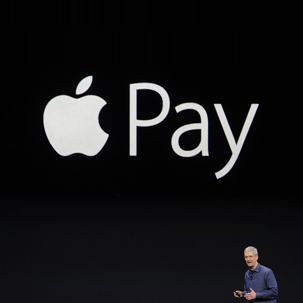 In 2014, Apple introduced its own payment system to the world - Apple Rau. Apple Rau’s payment support tools are built into the new version of the iPhone 6 smartphone, equipped with a fingerprint reader and NFC chip for contactless payment for goods.
In 2014, Apple introduced its own payment system to the world - Apple Rau. Apple Rau’s payment support tools are built into the new version of the iPhone 6 smartphone, equipped with a fingerprint reader and NFC chip for contactless payment for goods.
Visa, Mastercard and American Express have already expressed their willingness to work with Apple Rau. Not against cooperation and banks serving credit cards of users of the new system. It is expected that interest in Apple Rau will only grow over time.
You can use the payment service using the credit card information stored in your iTunes account. To change a card or add a new credit card, it is enough to take a photo of it and send the resulting image to the system. Later, when carrying out transactions, the card number is not used anywhere and is not stored, it is also not used for authorization in the system, the system is entered using a unique one-time code. Those. Users can be confident in the security of their accounts.
6. Separation of eBay and PayPal
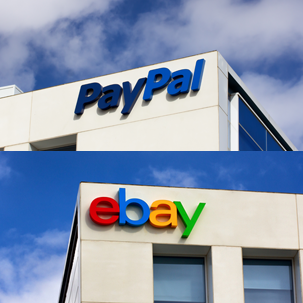 In 2014, the largest online trading platform announced the branch of PayPal, an electronic money operator that was (and was still) a division of eBay until the beginning of 2015. This is despite the fact that a year ago, the head of eBay, John Donahoe, argued that "payments and commerce belong to each other," and that "eBay and PayPal are better together."
In 2014, the largest online trading platform announced the branch of PayPal, an electronic money operator that was (and was still) a division of eBay until the beginning of 2015. This is despite the fact that a year ago, the head of eBay, John Donahoe, argued that "payments and commerce belong to each other," and that "eBay and PayPal are better together."
Following the separation, PayPal plans to present its shares on the stock exchange. This will allow the service to go into free navigation and conduct independent activities on the choice of partners and the model by which these partnerships will develop, as well as allow independent competition with other systems. In turn, eBay will be able to connect other electronic systems to its platform, which also gives the retailer a large space for developing partnerships that were previously unavailable to it.
Thus, we can say that this is a mutually beneficial "separation" by mutual consent. Separation, however, does not mean that from now on the two e-commerce giants will not cooperate at all, the format of their interrelations will change.
7. Chinese online store Alibaba presented shares on the New York Stock Exchange
 Between the release of Apple Pay and eBay's PayPal branch, on the New York Stock Exchange, a large Chinese online store, Alibaba, set its records, becoming the first newcomer on the exchange to receive such a high rating.
Between the release of Apple Pay and eBay's PayPal branch, on the New York Stock Exchange, a large Chinese online store, Alibaba, set its records, becoming the first newcomer on the exchange to receive such a high rating.
Recall that on September 18, after the initial public offering of its shares, the retailer attracted as much as $ 25 billion. Today, Alibaba’s market capitalization is already 259 billion, which is ahead of not only eBay ($ 60 billion) and Amazon ($ 140 billion), but also Walmart, a popular network of universal retail stores ($ 239 billion).
It's no secret that Alibaba is the largest player in the Chinese e-commerce market. Every day of the outgoing year brought the retailer almost 10 billion dollars and today sales in China continue to grow.
The Chinese Internet giant is becoming crowded in its own market; in the near future, the company is entering the global arena. Placing shares on the largest overseas stock exchange is the first step towards the development of new horizons. Among other actions taken by the retailer to attract new customers is the translation of the site into Portuguese. This will cover the Brazilian market, are confident in Alibaba.
Experts predict that the marketplace has every chance to spread its influence around the world, because Alibaba is not just an online store, but a whole complex that includes the Alipay payment system, a developed system of logistics and delivery, insurance, messaging, social media, as well as a group of investors.
8. Opening the first offline store Amazon
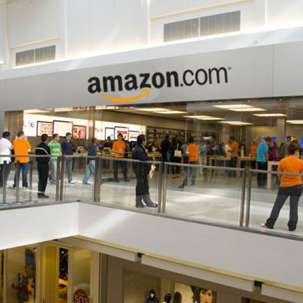 Amazon is another dominant player in the e-commerce market. The company decided to open its first real store. Amazon is confident that this will allow them to strengthen their already strong position in the retail sector, to establish physical, human ties with their customers. Such a communication format can be the key to working with individual customers and help attract even more users (recall that today Amazon customers are already 220 million people).
Amazon is another dominant player in the e-commerce market. The company decided to open its first real store. Amazon is confident that this will allow them to strengthen their already strong position in the retail sector, to establish physical, human ties with their customers. Such a communication format can be the key to working with individual customers and help attract even more users (recall that today Amazon customers are already 220 million people).
Offline store will help improve the quality of customer service of the company, speed up the delivery of orders and establish a quick exchange and return of goods. The real store will be a full collection point, where visitors will be able to pick up orders placed on the Amazon website. The Wall Street Journal says the store will be located in Manhattan, opposite the famous Empire State Building skyscraper.
9. Bitcoin retreats
 Financial news agency Bloomberg called Bitcoin the worst currency of 2014.
Financial news agency Bloomberg called Bitcoin the worst currency of 2014.
Throughout 2013, Bitcoin has steadily added in price, users of virtual currency rejoiced, because by the end of the year, the cryptocurrency rate reached its maximum ($ 1,130). But the joy was premature. Already at the beginning of 2014, the electronic currency, having passed the peak of its value, rushed down and continued an uncontrollable fall, until it lost more than 70% of its value, stopping briefly at $ 770, and then continuing to fall to $ 326.
10 Consolidation of large companies
 Looking back and analyzing the e-commerce market, you can see that in 2014, the general interest in online payments has increased significantly compared with 2013. Not least, this is due to the consolidation of several large companies.
Looking back and analyzing the e-commerce market, you can see that in 2014, the general interest in online payments has increased significantly compared with 2013. Not least, this is due to the consolidation of several large companies.
At the beginning of 2014, the Visa and Chase agreement came into force, giving the latter the right to independently create direct links between card issuers and trading platforms. Technology company Vantiv has completed the purchase of the Mercury payment service. The QIWI company acquired the Money Mail.ru payment service. The international payment system PayPal and the company that produces digital gift cards CashStar concluded a major transaction for the release and further sale of gift certificates PayPal.
Thus, a certain redistribution of forces took place in the market, as a result of which the largest and strongest players took decisive steps to strengthen their positions, concluding advantageous agreements with their partners or engulfing competitors.
So, we reviewed 10 key events that occurred in 2014 and had an impact on the development of electronic payment systems.
But what awaits us in the future, the 2015th year? The same expert made her predictions and shared her assumptions.
In 2001, many analysts predicted that the volume of mobile payments in 2008 would be $ 37 billion. The assumption was made 6 years before the first iPhone entered the market.
In 2009, the same analysts said that the volume of mobile payments in 2012 will amount to 10 billion (note the decrease in the forecast value by 27 billion). The forecast was made 2 years after the release of the first iPhone and the launch of the App Store, when less than 5 percent of the population of our planet used smartphones.
In 2012, analysts predicted a growth in mobile payments to $ 2 billion (although, based on their previous forecasts, it would be more logical to say about the reduction of payments from 10 to 2 billion).
As you can see, accurate forecasts are not easy and unreliable; no one can guarantee the growth of mobile payments volume or its decline next year with 100 percent certainty. However, some events can be foreseen. And here are some of them.
1. Traders - a phased increase in income
In the coming years, traders will no doubt focus on finding reliable partners, interaction with which will allow them to increase the income of their trading platforms. However, to obtain the desired profit immediately fail.
As you know, every year an increasing number of customers from various trading platforms are switching to online space and an increasing number of customers from traditional stores are using mobile devices to make purchases. The seller can not respond to this. Traders have to follow technical mode and be aware of all technical innovations, applying them in the right place at the right time.
Of course, the introduction of all the techno-new products requires a significant investment of funds and a clear strategy. The seller must understand why he does it and what he will ultimately receive.
Studies show that in 2015, 93% of traders will invest in the development of mobile applications, 74% say they will invest in applications that somewhat increase the consumer's trade route - special offers and recommendations. More than half say that the future is mobile Wi-Fi beacons, establishing effective interaction with the consumer. A third of the retailers surveyed are counting on increasing turnover through a revision of the pricing policy.
2. Payment networks - the road to the unknown
Daily payment networks process a huge number of transactions involving plastic cards. And every day their volume is growing due to the development of payment mechanisms and, not least, the cooperation with such a major player in the field of mobile commerce, as Apple Pay. The partnership with Apple, among other things, also contributes to the development and early implementation of innovations in the market of electronic payments. Of course, all this favorably affects the development of e-commerce. But this is the situation today, and what no one can expect in the field of mobile payments tomorrow and whether other systems will want to cooperate with Apple Pay in the future, nobody can say with complete confidence.
So, today, plastic card issuers pay Apple 0.15% for each transaction of their depositor, banks and payment systems invest their own money in advertising Apple payments among their customers. Millions of dollars have already been spent for this purpose. And, most likely, the situation will only worsen.
Moreover, an increasing number of electronic wallets that do not use plastic cards are entering the market, which cannot but be disturbed by payment systems. For example, the Chinese system Alipay has more than 300 million mobile wallets that are not tied to payment cards.
Based on this, we can assume that already in 2015, the payment systems will think about creating their own advanced electronic payment system and will begin to look for alternative sources of income.
3. Banks - need to match
Recently, more and more banks have come to the conclusion that the discovery / development of their online services is a necessity due to the widespread introduction of digital technologies and the gradual change in user preferences.
The emergence of various financial companies offering P2P lending will also force banks to modernize their system, reshape business models, develop new and new products that might interest a potential client. The introduction of new technologies, of course, will require large cash infusions from banks. But in the near future they will not have to choose. All these measures are necessary for banks to resist in a difficult competition not only with traditional, but also with virtual financial companies.
4. Consumers - the need to adapt
Today in the world there are many services for making mobile payments, but this does not mean that all consumers like this payment method or that everyone uses it in practice. On the contrary, most modern buyers use more traditional methods, familiar and familiar, only some users are looking for new, progressive methods of payment for goods on their own. . . , InfoScout, Bitcoin , , .
, , , , , . , .
Alipay PayPal, -, Amazon, , M-Pesa, . , , , .
5. POS- –
POS- . « » , , .
POS-, , , - .
6. –
– , .
, -. , , 1 , 1 - , - . , 62% 1 .
– , .
, , . , , .
7. –
, , . - , - .
, , , , . , , – .
, , . , , , , , SIM-, NF-.
8. –
, , . , 2020- 50 , , .. 7 .
– , . , .
, .
,
 2014 , , . , . , .
2014 , , . , . , .
, , .
2015- , . , , !
But first, let's stop on the results of the year of the past. So, the expert Karen Webster formulated the main world events of the payment market of the outgoing year.
TOP 10 events affecting the electronic payment system in 2014
1. Large-scale cyber attack on the Target distribution network
')
 At the end of 2013, a large trading network Target, which is owned by the same-name American company, was attacked by hackers, as a result of which scammers got access to information on 40 million bank cards. After this incident, customer confidence in the network dropped sharply, and with it immediately, sales volumes fell by 46%. How did this event affect payments in 2014, you ask? The most direct.
At the end of 2013, a large trading network Target, which is owned by the same-name American company, was attacked by hackers, as a result of which scammers got access to information on 40 million bank cards. After this incident, customer confidence in the network dropped sharply, and with it immediately, sales volumes fell by 46%. How did this event affect payments in 2014, you ask? The most direct.Almost immediately after the attack, Target began large-scale work to prevent such attacks in the future. Cyber attack allowed to prioritize the company - henceforth, security is paramount.
Of course, after Target, other retail chains also thought about the security of their customers' personal data. Gradually, during the whole of 2014, a new standard of security for payment transactions was formed, more and more companies put cybersecurity on the first step of their priorities. And now, by the end of the year, we can argue that a cyber attack on the Target distribution network (although this is not the only case of identity theft, there were attacks before and after, but the attack on Target was the most resonant) showed the scale of the possible consequences and prompted all large companies to review their policies and focus on protecting their customers' data. In the future, work on the improvement of protective measures will be continued, including in the sphere of Internet-commerce.
2. Introduction of contactless cards in the USA
 Before the attack on Target, America was skeptical of EMV, the international standard for working with chip cards in general, and contactless payment cards in particular. Most users prefer magnetic stripe cards, considering them completely safe. The peace of mind of cardholders was largely due to the statistics, because before the attack on Target the level of magnetic card fraud was very low. In addition, the introduction of new technology of contactless payments required large cash inflows.
Before the attack on Target, America was skeptical of EMV, the international standard for working with chip cards in general, and contactless payment cards in particular. Most users prefer magnetic stripe cards, considering them completely safe. The peace of mind of cardholders was largely due to the statistics, because before the attack on Target the level of magnetic card fraud was very low. In addition, the introduction of new technology of contactless payments required large cash inflows.After weighing all the pros and cons, the Americans found unfounded spending on such "trifles". And in vain. After all, a contactless card, thanks to the special encryption of the personal data of its owner, is capable of providing a level of security an order of magnitude higher than its magnetic predecessor.
The cyber attack on Target made its adjustments and forced the US government to reconsider its attitude to the new technology. Currently, both in America and in other countries of the world, active work is being carried out on the introduction of a system of contactless payments.
However, full re-equipment of payment systems will take at least 5 years, and by the end of 2015 only 25% of the total number of payment terminals will accept new-style cards.
3. Introduction of tokenization
 2014, as we have already noted, was a year of safe trading. One of the ways to ensure the security of payments was the introduction of tokenization, the principle of which, however, is no longer new.
2014, as we have already noted, was a year of safe trading. One of the ways to ensure the security of payments was the introduction of tokenization, the principle of which, however, is no longer new.The service is based on the principles of the EMV-standard bank payments. At the moment when the customer makes a purchase in the online store using his plastic card or mobile device, the number of the personal account of the card is converted into a token (the number of the personal account of the device). The latter can be stored directly in the online store or on a mobile device without the risk of data leakage, since it does not contain any significant information about the cardholder and the transaction made. In turn, tokens allow making instant payments and greatly simplify the process of settlement transactions in the field of electronic and mobile commerce.
In the outgoing year, one by one tokenization was introduced into its system by 2 major players - Visa and American Express. It is expected that other systems will soon join them.
4. Using smartphones to communicate directly with customers
 In 2013, Apple introduced its new iBeacons mobile app to the world — a cheap and effective way to establish a two-way dialogue with the consumer.
In 2013, Apple introduced its new iBeacons mobile app to the world — a cheap and effective way to establish a two-way dialogue with the consumer.In 2014, similar mobile applications were also available to owners of Android devices, and over time gained great popularity. Their main task is to notify owners of devices about promotions and discounts of various retail stores. Distribution of applications are mainly engaged in large shopping centers interested in increasing sales.
The principle of operation of such programs is simple. As soon as a potential buyer appears in the shopping center, the retailer will find out about it with the help of special beacons installed throughout the center. They are designed to receive a signal from a mobile device and send response messages about promotions and discounts acting on a particular product.
How to choose the right time to send this or that information? Yes, very simple. Special beacons not only establish the presence of the client, but also serve his movement through the supermarket. The buyer receives a message with the terms of the current special offer as soon as he approaches the promotional item. Communication between the beacons and the mobile device of the shopping center visitor takes place via Wi-Fi or Bluetooth.
5. Apple's entry into the payments market
 In 2014, Apple introduced its own payment system to the world - Apple Rau. Apple Rau’s payment support tools are built into the new version of the iPhone 6 smartphone, equipped with a fingerprint reader and NFC chip for contactless payment for goods.
In 2014, Apple introduced its own payment system to the world - Apple Rau. Apple Rau’s payment support tools are built into the new version of the iPhone 6 smartphone, equipped with a fingerprint reader and NFC chip for contactless payment for goods.Visa, Mastercard and American Express have already expressed their willingness to work with Apple Rau. Not against cooperation and banks serving credit cards of users of the new system. It is expected that interest in Apple Rau will only grow over time.
You can use the payment service using the credit card information stored in your iTunes account. To change a card or add a new credit card, it is enough to take a photo of it and send the resulting image to the system. Later, when carrying out transactions, the card number is not used anywhere and is not stored, it is also not used for authorization in the system, the system is entered using a unique one-time code. Those. Users can be confident in the security of their accounts.
6. Separation of eBay and PayPal
 In 2014, the largest online trading platform announced the branch of PayPal, an electronic money operator that was (and was still) a division of eBay until the beginning of 2015. This is despite the fact that a year ago, the head of eBay, John Donahoe, argued that "payments and commerce belong to each other," and that "eBay and PayPal are better together."
In 2014, the largest online trading platform announced the branch of PayPal, an electronic money operator that was (and was still) a division of eBay until the beginning of 2015. This is despite the fact that a year ago, the head of eBay, John Donahoe, argued that "payments and commerce belong to each other," and that "eBay and PayPal are better together."Following the separation, PayPal plans to present its shares on the stock exchange. This will allow the service to go into free navigation and conduct independent activities on the choice of partners and the model by which these partnerships will develop, as well as allow independent competition with other systems. In turn, eBay will be able to connect other electronic systems to its platform, which also gives the retailer a large space for developing partnerships that were previously unavailable to it.
Thus, we can say that this is a mutually beneficial "separation" by mutual consent. Separation, however, does not mean that from now on the two e-commerce giants will not cooperate at all, the format of their interrelations will change.
7. Chinese online store Alibaba presented shares on the New York Stock Exchange
 Between the release of Apple Pay and eBay's PayPal branch, on the New York Stock Exchange, a large Chinese online store, Alibaba, set its records, becoming the first newcomer on the exchange to receive such a high rating.
Between the release of Apple Pay and eBay's PayPal branch, on the New York Stock Exchange, a large Chinese online store, Alibaba, set its records, becoming the first newcomer on the exchange to receive such a high rating.Recall that on September 18, after the initial public offering of its shares, the retailer attracted as much as $ 25 billion. Today, Alibaba’s market capitalization is already 259 billion, which is ahead of not only eBay ($ 60 billion) and Amazon ($ 140 billion), but also Walmart, a popular network of universal retail stores ($ 239 billion).
It's no secret that Alibaba is the largest player in the Chinese e-commerce market. Every day of the outgoing year brought the retailer almost 10 billion dollars and today sales in China continue to grow.
The Chinese Internet giant is becoming crowded in its own market; in the near future, the company is entering the global arena. Placing shares on the largest overseas stock exchange is the first step towards the development of new horizons. Among other actions taken by the retailer to attract new customers is the translation of the site into Portuguese. This will cover the Brazilian market, are confident in Alibaba.
Experts predict that the marketplace has every chance to spread its influence around the world, because Alibaba is not just an online store, but a whole complex that includes the Alipay payment system, a developed system of logistics and delivery, insurance, messaging, social media, as well as a group of investors.
8. Opening the first offline store Amazon
 Amazon is another dominant player in the e-commerce market. The company decided to open its first real store. Amazon is confident that this will allow them to strengthen their already strong position in the retail sector, to establish physical, human ties with their customers. Such a communication format can be the key to working with individual customers and help attract even more users (recall that today Amazon customers are already 220 million people).
Amazon is another dominant player in the e-commerce market. The company decided to open its first real store. Amazon is confident that this will allow them to strengthen their already strong position in the retail sector, to establish physical, human ties with their customers. Such a communication format can be the key to working with individual customers and help attract even more users (recall that today Amazon customers are already 220 million people).Offline store will help improve the quality of customer service of the company, speed up the delivery of orders and establish a quick exchange and return of goods. The real store will be a full collection point, where visitors will be able to pick up orders placed on the Amazon website. The Wall Street Journal says the store will be located in Manhattan, opposite the famous Empire State Building skyscraper.
9. Bitcoin retreats
 Financial news agency Bloomberg called Bitcoin the worst currency of 2014.
Financial news agency Bloomberg called Bitcoin the worst currency of 2014.Throughout 2013, Bitcoin has steadily added in price, users of virtual currency rejoiced, because by the end of the year, the cryptocurrency rate reached its maximum ($ 1,130). But the joy was premature. Already at the beginning of 2014, the electronic currency, having passed the peak of its value, rushed down and continued an uncontrollable fall, until it lost more than 70% of its value, stopping briefly at $ 770, and then continuing to fall to $ 326.
10 Consolidation of large companies
 Looking back and analyzing the e-commerce market, you can see that in 2014, the general interest in online payments has increased significantly compared with 2013. Not least, this is due to the consolidation of several large companies.
Looking back and analyzing the e-commerce market, you can see that in 2014, the general interest in online payments has increased significantly compared with 2013. Not least, this is due to the consolidation of several large companies.At the beginning of 2014, the Visa and Chase agreement came into force, giving the latter the right to independently create direct links between card issuers and trading platforms. Technology company Vantiv has completed the purchase of the Mercury payment service. The QIWI company acquired the Money Mail.ru payment service. The international payment system PayPal and the company that produces digital gift cards CashStar concluded a major transaction for the release and further sale of gift certificates PayPal.
Thus, a certain redistribution of forces took place in the market, as a result of which the largest and strongest players took decisive steps to strengthen their positions, concluding advantageous agreements with their partners or engulfing competitors.
So, we reviewed 10 key events that occurred in 2014 and had an impact on the development of electronic payment systems.
But what awaits us in the future, the 2015th year? The same expert made her predictions and shared her assumptions.
What awaits the scope of payments in the 2015th year
In 2001, many analysts predicted that the volume of mobile payments in 2008 would be $ 37 billion. The assumption was made 6 years before the first iPhone entered the market.
In 2009, the same analysts said that the volume of mobile payments in 2012 will amount to 10 billion (note the decrease in the forecast value by 27 billion). The forecast was made 2 years after the release of the first iPhone and the launch of the App Store, when less than 5 percent of the population of our planet used smartphones.
In 2012, analysts predicted a growth in mobile payments to $ 2 billion (although, based on their previous forecasts, it would be more logical to say about the reduction of payments from 10 to 2 billion).
As you can see, accurate forecasts are not easy and unreliable; no one can guarantee the growth of mobile payments volume or its decline next year with 100 percent certainty. However, some events can be foreseen. And here are some of them.
1. Traders - a phased increase in income
In the coming years, traders will no doubt focus on finding reliable partners, interaction with which will allow them to increase the income of their trading platforms. However, to obtain the desired profit immediately fail.
As you know, every year an increasing number of customers from various trading platforms are switching to online space and an increasing number of customers from traditional stores are using mobile devices to make purchases. The seller can not respond to this. Traders have to follow technical mode and be aware of all technical innovations, applying them in the right place at the right time.
Of course, the introduction of all the techno-new products requires a significant investment of funds and a clear strategy. The seller must understand why he does it and what he will ultimately receive.
Studies show that in 2015, 93% of traders will invest in the development of mobile applications, 74% say they will invest in applications that somewhat increase the consumer's trade route - special offers and recommendations. More than half say that the future is mobile Wi-Fi beacons, establishing effective interaction with the consumer. A third of the retailers surveyed are counting on increasing turnover through a revision of the pricing policy.
2. Payment networks - the road to the unknown
Daily payment networks process a huge number of transactions involving plastic cards. And every day their volume is growing due to the development of payment mechanisms and, not least, the cooperation with such a major player in the field of mobile commerce, as Apple Pay. The partnership with Apple, among other things, also contributes to the development and early implementation of innovations in the market of electronic payments. Of course, all this favorably affects the development of e-commerce. But this is the situation today, and what no one can expect in the field of mobile payments tomorrow and whether other systems will want to cooperate with Apple Pay in the future, nobody can say with complete confidence.
So, today, plastic card issuers pay Apple 0.15% for each transaction of their depositor, banks and payment systems invest their own money in advertising Apple payments among their customers. Millions of dollars have already been spent for this purpose. And, most likely, the situation will only worsen.
Moreover, an increasing number of electronic wallets that do not use plastic cards are entering the market, which cannot but be disturbed by payment systems. For example, the Chinese system Alipay has more than 300 million mobile wallets that are not tied to payment cards.
Based on this, we can assume that already in 2015, the payment systems will think about creating their own advanced electronic payment system and will begin to look for alternative sources of income.
3. Banks - need to match
Recently, more and more banks have come to the conclusion that the discovery / development of their online services is a necessity due to the widespread introduction of digital technologies and the gradual change in user preferences.
The emergence of various financial companies offering P2P lending will also force banks to modernize their system, reshape business models, develop new and new products that might interest a potential client. The introduction of new technologies, of course, will require large cash infusions from banks. But in the near future they will not have to choose. All these measures are necessary for banks to resist in a difficult competition not only with traditional, but also with virtual financial companies.
4. Consumers - the need to adapt
Today in the world there are many services for making mobile payments, but this does not mean that all consumers like this payment method or that everyone uses it in practice. On the contrary, most modern buyers use more traditional methods, familiar and familiar, only some users are looking for new, progressive methods of payment for goods on their own. . . , InfoScout, Bitcoin , , .
, , , , , . , .
Alipay PayPal, -, Amazon, , M-Pesa, . , , , .
5. POS- –
POS- . « » , , .
POS-, , , - .
6. –
– , .
, -. , , 1 , 1 - , - . , 62% 1 .
– , .
, , . , , .
7. –
, , . - , - .
, , , , . , , – .
, , . , , , , , SIM-, NF-.
8. –
, , . , 2020- 50 , , .. 7 .
– , . , .
, .
,
 2014 , , . , . , .
2014 , , . , . , ., , .
2015- , . , , !
Source: https://habr.com/ru/post/247295/
All Articles